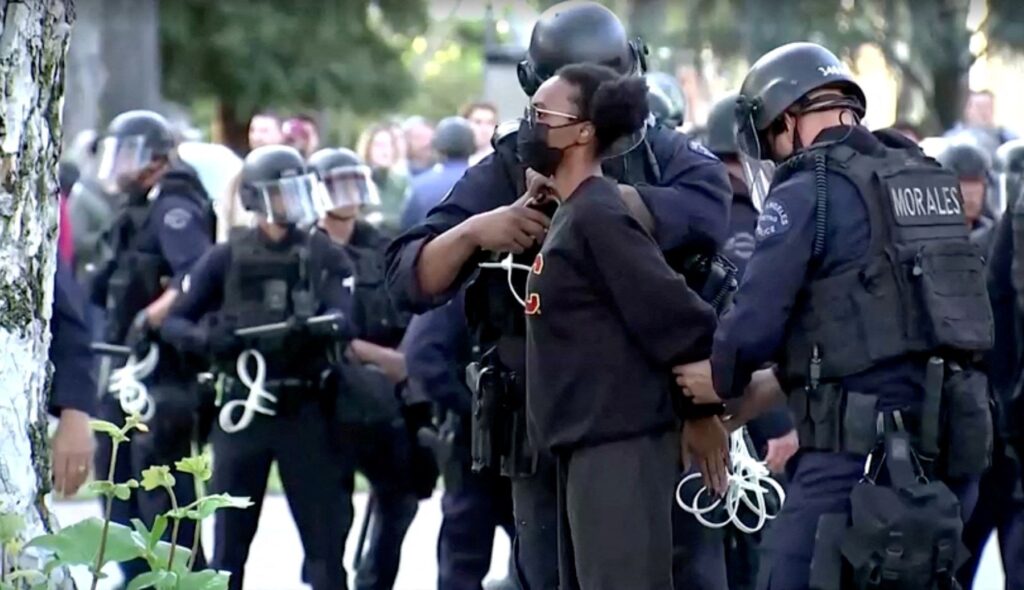As Israel continues its genocidal war on Gaza, the cracks in American society are becoming more visible, as college students on campuses across the country challenge the political establishment.
One side opposes US support for Israel and its pursuit of profits through investment in the defense industry, while the other supports Israeli attacks and encourages police action to break up student protest camps.
The rift reflects growing generational tensions in American society but also the media's stance on Israel's genocidal war in Gaza.
Pro-Israel activists in the US are trying to draw media attention to the anti-Semitic activity and destructive violence they say is widespread during campus protests.
The ploy serves two purposes: to divert attention from the debate about Israel's US-backed genocidal war against the Palestinians, and to silence pro-Palestinian voices by making criticism of Israel an anti-Semitic act punishable by law.
Evidence of the accusations against the student protesters is scarce. Nevertheless, the mainstream media has given them a lot of airtime and front page space. As a result, opponents and supporters of Israel's war on Gaza are now primarily debating the role of universities, the prevalence of anti-Semitism, and how the state and society should deal with both.
But how the mainstream media covered the campus protests is only one side of the story. The media itself, like society, is fragmented and polarized. In fact, we must talk about three media: the mainstream media that is steadily losing advertising and audiences and that broadly reflects the views of the US and Israeli governments, the brave, progressive independent media that disagrees with the mainstream view but is struggling to stay financially viable, and the kaleidoscopic world of social media that dominates a younger audience under the age of 30.
Israel’s war in Gaza has revealed how consumption of these three different media segments is linked to age groups and ideological sentiments – in other words, different media serve different sides of generational fault lines.
Surveys have consistently shown a correlation between age and differing political views, with younger people being more critical of the war and more supportive of the Palestinians than older people.
A February Pew Research Center survey found that 47% of Americans over 65 sympathize with Israelis and just 9% sympathize with Palestinians. Among younger Americans under 30, a third support the Palestinians and 14% support Israel.
Sixty percent of adults under 30 have a favorable view of Palestinians, compared with 46 percent who view Israelis favorably. Older Americans are more likely to view Israelis favorably than Palestinians.
Age also appears to determine media consumption patterns: An April poll by JL Partners found that 59% of young people get their news from social media, while the same percentage of people over 65 rely on mainstream TV or cable channels.
People who get their news primarily from mainstream or cable television “are more supportive of Israel's war effort, less likely to think Israel is committing war crimes, and less interested in war in general,” journalist Ryan Grimm wrote in the progressive publication The Intercept.
But Americans who turn to social media, podcasts and YouTube “generally side with the Palestinians, believe Israel is committing war crimes and genocide, and consider the issue very important,” he found.
Americans who rely on social media are increasingly exposed to articles and videos about the devastating effects of Israel's war on Gaza, which may increase their concerns about U.S. involvement. It is not surprising that students are vehemently protesting the war and demanding that universities divest from companies that fund the Israeli military and sever ties with Israeli academic institutions.
These demands challenge government policies and traditional pro-Israel groups, especially the older conservative political elite, which is why Congress and President Joe Biden reacted so quickly to the student protests and used the media to try to smear them with accusations of anti-Semitism.
Young Americans do not rely on mainstream media primarily because they see and feel the distortions, biases, and gaps in their reporting.
A good example of mainstream media bias can be seen in a recent analysis by pioneering digital disinformation researcher Mark Owen Jones, who reviewed 100 New York Times articles about protests on US college campuses published in April and early May and found that coverage emphasized the equating of the protests with anti-Semitism.
The study also found that despite an increase in both anti-Semitism and Islamophobia, the terms “anti-Semitism” and “anti-Semitic” appeared 296 times, while the terms “Islamophobia” and “Islamophobic” appeared only nine times.
And a March analysis of The New York Times' war coverage by the watchdog group newyorkwarcrimes.com came to similar findings. It also found a wide disparity in the sources used by the paper in its coverage of Palestine. The paper cites Israeli and American sources “more than three times as many as Palestinian sources.” Looking only at quotations from officials, it found that “Israeli and American officials are quoted nine times more than Palestinian.”
We should not be surprised that younger Americans live in a different news media world while older Americans grapple with the old media world that continues to fuel wars around the world.More importantly, these trends have been moving in the same direction for many years, portending continued societal polarization alongside growing support for Palestinian rights and a balanced U.S. stance on the Israeli-Palestinian conflict.
The views expressed in this article are the author's own and do not necessarily reflect Al Jazeera's editorial policy.



